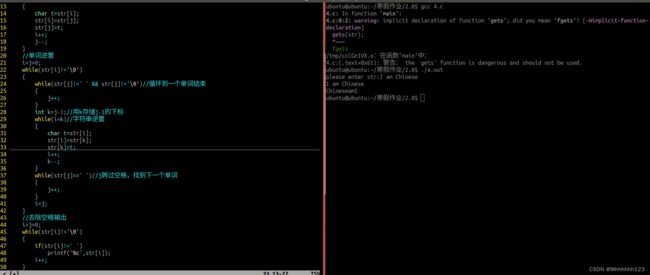- Linux系统配置(应用程序)
1风天云月
Linuxlinux应用程序编译安装rpmhttp
目录前言一、应用程序概述1、命令与程序的关系2、程序的组成3、软件包封装类型二、RPM1、RPM概述2、RPM用法三、编译安装1、解包2、配置3、编译4、安装5、启用httpd服务结语前言在Linux中的应用程序被视为将软件包安装到系统中后产生的各种文档,其中包括可执行文件、配置文件、用户手册等内容,这些文档被组织为一个有机的整体,为用户提供特定的功能,因此对于“安装软件包”与“安装应用程序”这两
- 包含日志获取webshell
陈望_ning
日志文件关闭:Apache目录下的httpd.conf文件#ErrorLog"logs/error.log"#CustomLog"logs/access.log"common加#号为注释不产生日志文件如果去掉#将会在Apache/logs/目录下产生日志文件linux:access_logerror_logwindows:access.logerror.logaccess_log每一行记录了一次网
- Android 应用权限管理详解
文章目录1.权限类型2.权限请求机制3.权限组和分级4.权限管理的演进5.权限监控和SELinux强制访问控制6.应用权限审核和GooglePlayProtect7.开发者最佳实践8.用户权限管理9.Android应用沙箱模型10.ScopedStorage(分区存储)11.背景位置权限(BackgroundLocationAccess)12.权限回收和自动清理13.权限请求的用户体验设计14.G
- centos7安装配置 Anaconda3
Anaconda是一个用于科学计算的Python发行版,Anaconda于Python,相当于centos于linux。下载[root@testsrc]#mwgethttps://mirrors.tuna.tsinghua.edu.cn/anaconda/archive/Anaconda3-5.2.0-Linux-x86_64.shBegintodownload:Anaconda3-5.2.0-L
- 分布式链路追踪系统架构设计:从理论到企业级实践
ma451152002
java分布式系统架构
分布式链路追踪系统架构设计:从理论到企业级实践本文深入探讨分布式链路追踪系统的架构设计原理、关键技术实现和企业级应用实践,为P7架构师提供完整的技术方案参考。目录引言:分布式链路追踪的重要性核心概念与技术原理系统架构设计数据模型与协议标准核心组件架构设计性能优化与扩展性设计企业级实施策略技术选型与对比分析监控与运维体系未来发展趋势P7架构师面试要点引言:分布式链路追踪的重要性微服务架构下的挑战在现
- K8S 常用命令全解析:高效管理容器化集群
恩爸编程
dockerkubernetes容器k8s常用命令k8s有哪些常用命令k8s命令有哪些K8S常用命令有哪些
K8S常用命令全解析:高效管理容器化集群一、引言Kubernetes(K8S)作为强大的容器编排平台,其丰富的命令行工具(kubectl)为用户提供了便捷的方式来管理集群中的各种资源。熟练掌握K8S常用命令对于开发人员和运维人员至关重要,能够有效提高容器化应用的部署、监控与维护效率。本文将详细介绍一些K8S常用命令及其使用案例。二、基础资源操作命令(一)kubectlcreate功能:用于创建K8
- PDF转Markdown - Python 实现方案与代码
Eiceblue
PythonPythonPDFpdfpython开发语言vscode
PDF作为广泛使用的文档格式,转换为轻量级标记语言Markdown后,可无缝集成到技术文档、博客平台和版本控制系统中,提高内容的可编辑性和可访问性。本文将详细介绍如何使用国产Spire.PDFforPython库将PDF文档转换为Markdown格式。技术优势:精准保留原始文档结构(段落/列表/表格)完整提取文本和图像内容无需Adobe依赖的纯Python实现支持Linux/Windows/mac
- 在Windows11上安装Linux操作系统的几种技术方案
yuanpan
linux运维服务器
在Windows11上安装Linux主要有以下几种技术方案,每种方案适用于不同的需求场景:1.WindowsSubsystemforLinux(WSL)适用场景:开发、命令行工具、轻量级Linux环境支持发行版:Ubuntu、Debian、KaliLinux、Fedora等优点:轻量级:无需虚拟机,直接在Windows上运行Linux命令行环境。无缝集成:可访问Windows文件系统,支持VSCo
- 从零到一:基于差分隐私决策树的客户购买预测系统实战开发
笙囧同学
决策树算法机器学习
作者简介:笙囧同学,中科院计算机大模型方向硕士,全栈开发爱好者联系方式:
[email protected]各大平台账号:笙囧同学座右铭:偷懒是人生进步的阶梯文章导航快速导航前言-项目背景与价值项目概览-系统架构与功能技术深度解析-核心算法原理️系统实现详解-工程实践细节性能评估与分析-实验结果分析Web系统开发-前后端开发部署与运维-DevOps实践完整复现指南-手把手教程️实践案例与故障排除-问
- Claude Code 超详细完整指南(2025最新版)
笙囧同学
python
终端AI编程助手|高频使用点+生态工具+完整命令参考+最新MCP配置目录快速开始(5分钟上手)详细安装指南系统要求Windows安装(WSL方案)macOS安装Linux安装安装验证配置与认证首次认证环境变量配置代理配置⚡基础命令详解启动命令会话管理文件操作Think模式完全指南MCP服务器配置详解MCP基础概念添加MCP服务器10个必备MCP服务器MCP故障排除记忆系统详解高级使用技巧成本控制策
- 如何在 Ubuntu 24.04 或 22.04 Linux 上安装和运行 Redis 服务器
山岚的运维笔记
Linux运维及使用linux服务器ubunturedis数据库
Redis(RemoteDictionaryServer,远程字典服务器)是一种内存数据结构存储,通常用作NoSQL数据库、缓存和消息代理。它是开源的,因此用户可以免费安装,无需支付任何费用。Redis旨在为需要快速数据访问和低延迟的应用程序提供速度和效率。Redis支持多种数据类型,包括字符串(Strings)、列表(Lists)、集合(Sets)、哈希(Hashes)、有序集合(SortedS
- Linux中Samba服务器安装与配置文件
長樂.-
linux运维服务器
Samba简述27zkqsamba是一个基于TCP/IP协议的开源软件套件,可以在Linux、Windows、macOS等操作系统上运行。它允许不同操作系统的计算机之间实现文件和打印机共享。samba提供了一个服务,使得Windows操作系统可以像访问本地文件一样访问Linux、Mac等操作系统上的共享文件。实现跨平台的文件共享,提高办公环境的效率和便利性。samba也支持Windows网络邻居协
- Docker
℡余晖^
黑马点评项目相关问题和笔记dockereureka容器
在黑马点评项目中,在谈到Redisson解决redis的主从一致性问题时,弹幕提到了Docker,本文来简单了解一下Docker,我的初步理解运维是维护多个集群的稳定,那它和VM虚拟机的区别又是什么?,如果要更深入地理解与学习(运维工程师),可以到b站搜索专门的课程(SpringCloud)。一、Docker是什么?重新理解“容器化”的本质1.1Docker的定义Docker是一个开源的容器化平台
- ubuntu qt环境下出现No suitable kits found解决方案
1.清理QtCreator缓存QtCreator会缓存项目配置、索引等数据,可能导致某些异常。清理方法:(1)删除QtCreator配置目录bashrm-rf~/.config/QtProject/(Ubuntu/Linux)或Windows:cmdrmdir/s/q"%APPDATA%\QtProject"(2)清除QtCreator的编译缓存bashrm-rf~/.cache/QtProjec
- 如何在 Ubuntu 24.04 或 22.04 Linux 上安装和使用 NoMachine
山岚的运维笔记
Linux运维及使用linuxubuntu运维nomachine远程连接
NoMachine是一款适用于Linux(Ubuntu)及其他支持的操作系统的远程桌面应用程序,允许用户通过本地或远程系统从世界任何地方控制计算机。它可以在低带宽连接下工作,被专业人士和家庭用户广泛使用。NoMachine的主要功能高性能远程访问跨平台兼容性易于使用,因为用户界面友好提供强大的加密协议,如SSH、SSL及其他安全标准支持远程文件传输和打印服务允许从远程计算机进行音频和视频流媒体传输
- linux实战--日志管理
简介日志文件重要的信息系统文件,及了许多重要的系统事件,包括用户的登录信息,系统的启动信息,系统的安全信息,邮寄相关信息,各种服务相关的信息。日志对安全也很重要。每天记录系统发生的各种事情,通过日志检查错误发生的原因或受到攻击时攻击者留下的痕迹。总的来说,日志是记录重大事件的文件。处理日志的工具rsyslog系统日志管理专职管理日志的工具,它产生各种信息文件,主要存放在/var/loglogrot
- Windows系统第一次运行C语言程序,环境配置,软件安装等遇到的坑及解决方法
灬爱码士灬
windowsc语言开发语言
明确需要编辑器和编译器,并选择自己要用什么(我选的编辑器是VSCode:VisualStudioCode;编译器是gcc)下载VSCode并配置环境变量(这里没啥问题),安装C/C++的拓展安装Cygwin,用来在Windows操作系统上模拟Unix/Linux环境(Cygwin官网:https://www.cygwin.com/。)安装过程中镜像可以选择https://mirrors.aliyu
- 一篇教你学会Git
编程界的彭于晏qaq
javaGITgit
从安装到高级使用(2025最新版)引言:为什么Git是开发者必备技能Git(GlobalInformationTracker)作为最流行的分布式版本控制系统,由Linux之父LinusTorvalds于2005年创建,现已成为软件开发的基础设施。与传统集中式版本控制系统(如SVN)相比,Git具有三大核心优势:分布式架构:每个开发者本地都有完整仓库副本,支持离线工作高效分支管理:创建和切换分支几乎
- 基本服务 FTP & SMB
会飞的灰大狼
Centos7linux
基本服务FTP&SMB前言:FTP简称为文件传输协议前面说的他可以做到备份的功能那么它可以做到文件传输的过程smb我们简单来说共享文件夹NFSNFS(NetworkFileSystem,网络文件系统)是一种分布式文件系统协议,允许不同计算机之间通过网络共享文件和目录,使远程文件系统像本地文件系统一样被访问。它最初由SunMicrosystems开发,现在已成为UNIX/Linux系统中常用的网络
- Ubuntu lamp
会飞的灰大狼
linuxubuntu
Ubuntulamp前言在Ubuntu安装lamp架构我们了解到lamp是完整的架构我们前面了解到了集合了Linux系统apacheMySQL和PHP语言的完整架构我们前面说了Centos7中编译安装lamp那么我们去说一下在Ubuntu中安装安装apache2apt直接安装apache2apt-yinstallapache2启动apache2systemctlstartapache2#测
- 9、Docker Compose 实战
小醉你真好
#部署不求人docker容器运维
DockerCompose实战教程(含完整Nginx案例+配置项详解)适合读者:开发者、后端工程师、运维工程师、初学者环境要求:CentOS9+Docker已安装教程亮点:实战驱动、配置项详解、挂载说明、可直接复制使用标签:#Docker#DockerCompose#运维实战#Nginx部署一、什么是DockerCompose?DockerCompose是Docker官方推出的多容器应用编排工具,
- Linux文件权限与进程管理解析
雨季西柚
linux
控制对文件的访问1。什么是文件系统权限?它是如何工作的?如何查看文件的权限?答:文件系统权限就是规定谁能对文件/文件夹做什么(比如看、改、删)的规则。简单说,就是分"所有者、所属组、其他人"三类,给每类分配"读、写、执行"三种权限。操作时系统先看你属于哪类,再查有没有对应权限,有就允许,没有就拦着。查看方式:Linux/mac:终端输ls-l文件名,看开头的rwxr--r--这类字符(3个一组,对
- 塔能科技物联运维平台及城市照明市场竞争力分析
塔能物联运维
大数据
关于塔能科技的物联运维平台,就其在城市照明领域所具备的市场竞争力而言,可以从技术架构层面、行业适配的实际情况、市场策略方面以及所面临的种种挑战等不同角度展开剖析。一、物联运维平台的核心竞争力1.技术架构优势-全协议兼容的物联网接入能力其能够适配诸如LPWAN(涵盖LoRa、NB-IoT等)、4G/5G、Zigbee这类多种多样的协议,并且可以同时接入像照明设备、环境监测仪器以及电力设施等各不相同类
- 【Linux内核模块】调试技巧
byte轻骑兵
#嵌入式Linux驱动开发实战linux
内核模块开发最让人头疼的不是写代码,而是调试——代码编译通过了,加载后却要么没反应,要么直接让系统崩溃。这就像在黑屋子里修机器,看不见摸不着。其实内核调试有一套成熟的工具箱,掌握这些工具和技巧,就能给内核装个监控监控仪,让问题无所遁形。目录一、调试前的安全须知:别让系统崩溃二、最基础也最常用:printk打印日志2.1printk的基本用法2.2控制日志输出2.3printk的高级技巧三、内核Oo
- linux网卡显示未知未托管,linux有线网络显示设备未托管
NetworkManagerNetworkManager是为了使网络配置尽可能简单而开发的网络管理软件包,如果使用DHCP,NetworkManager会替换默认的路由表、从DHCP服务器获取IP地址并根据情况设置域名服务器,NetworkManager的目标是使网络能够开箱即用。NetworkManager由两部分组成:一个以超级用户运行的守护进程(network-manager);一个前端管理
- DNF 与 YUM 的区别详解:从 CentOS 7 到 CentOS 9 的演进
DNF与YUM的区别详解:从CentOS7到CentOS9的演进标签:CentOS、YUM、DNF、Linux包管理、系统升级、兼容性适用版本:CentOS7、CentOS8、CentOS9一、背景介绍CentOS中使用的包管理工具是RedHat系列系统的重要组成部分。随着系统版本升级,包管理器从yum(CentOS7)逐渐过渡到dnf(CentOS8及之后版本)。二、YUM与DNF对比表对比项Y
- 在 CentOS 中安装 MySQL 的过程与问题解决方案
二向箔reverse
centosmysqllinux
MySQL是一款广泛使用的开源关系型数据库管理系统,在CentOS系统中安装MySQL是很多开发者和运维人员常做的工作。下面将详细介绍安装过程以及可能遇到的问题和解决方案。一、安装前的准备工作在安装MySQL之前,需要做好一些准备工作,以确保安装过程顺利进行。检查系统版本:确认CentOS的版本,不同版本在安装MySQL时可能会有一些差异。可以使用cat/etc/centos-release命令查
- Python简单练习3
第九条雀
python面试开发语言
1.技术面试题(1)解释Linux中的进程、线程和守护进程的概念,以及如何管理它们?答:1.进程:进程是程序的一次动态执行过程,是系统进行资源分配和调度的基本单位拥有独立的内存空间(代码段、数据段、堆栈等),进程间内存不共享包含进程PID、PPID、状态(运行、就绪、阻塞等)、优先级等属性进程间通信需通过管道、信号、共享内存等机制实现线程:线程是进程内的一个执行单元,是CPU调度的最小单位,共享所
- docker-基础入门
docker入门dockers安装1.首先如果系统中已经存在旧的Docker,则先卸载:yumremovedocker\docker-client\docker-client-latest\docker-common\docker-latest\docker-latest-logrotate\docker-logrotate\docker-engine\docker-selinux2.配置Dock
- 深入剖析Nginx
书火网_firebook
想邀看书之《深入剖析Nginx》一个不会点运维的后端程序员,不是个合格的码农传送门:https://fire100.top/detail?rId=155少年辛苦终身事,莫向光阴惰寸功!
- HttpClient 4.3与4.3版本以下版本比较
spjich
javahttpclient
网上利用java发送http请求的代码很多,一搜一大把,有的利用的是java.net.*下的HttpURLConnection,有的用httpclient,而且发送的代码也分门别类。今天我们主要来说的是利用httpclient发送请求。
httpclient又可分为
httpclient3.x
httpclient4.x到httpclient4.3以下
httpclient4.3
- Essential Studio Enterprise Edition 2015 v1新功能体验
Axiba
.net
概述:Essential Studio已全线升级至2015 v1版本了!新版本为JavaScript和ASP.NET MVC添加了新的文件资源管理器控件,还有其他一些控件功能升级,精彩不容错过,让我们一起来看看吧!
syncfusion公司是世界领先的Windows开发组件提供商,该公司正式对外发布Essential Studio Enterprise Edition 2015 v1版本。新版本
- [宇宙与天文]微波背景辐射值与地球温度
comsci
背景
宇宙这个庞大,无边无际的空间是否存在某种确定的,变化的温度呢?
如果宇宙微波背景辐射值是表示宇宙空间温度的参数之一,那么测量这些数值,并观测周围的恒星能量输出值,我们是否获得地球的长期气候变化的情况呢?
&nbs
- lvs-server
男人50
server
#!/bin/bash
#
# LVS script for VS/DR
#
#./etc/rc.d/init.d/functions
#
VIP=10.10.6.252
RIP1=10.10.6.101
RIP2=10.10.6.13
PORT=80
case $1 in
start)
/sbin/ifconfig eth2:0 $VIP broadca
- java的WebCollector爬虫框架
oloz
爬虫
WebCollector主页:
https://github.com/CrawlScript/WebCollector
下载:webcollector-版本号-bin.zip将解压后文件夹中的所有jar包添加到工程既可。
接下来看demo
package org.spider.myspider;
import cn.edu.hfut.dmic.webcollector.cra
- jQuery append 与 after 的区别
小猪猪08
1、after函数
定义和用法:
after() 方法在被选元素后插入指定的内容。
语法:
$(selector).after(content)
实例:
<html>
<head>
<script type="text/javascript" src="/jquery/jquery.js"></scr
- mysql知识充电
香水浓
mysql
索引
索引是在存储引擎中实现的,因此每种存储引擎的索引都不一定完全相同,并且每种存储引擎也不一定支持所有索引类型。
根据存储引擎定义每个表的最大索引数和最大索引长度。所有存储引擎支持每个表至少16个索引,总索引长度至少为256字节。
大多数存储引擎有更高的限制。MYSQL中索引的存储类型有两种:BTREE和HASH,具体和表的存储引擎相关;
MYISAM和InnoDB存储引擎
- 我的架构经验系列文章索引
agevs
架构
下面是一些个人架构上的总结,本来想只在公司内部进行共享的,因此内容写的口语化一点,也没什么图示,所有内容没有查任何资料是脑子里面的东西吐出来的因此可能会不准确不全,希望抛砖引玉,大家互相讨论。
要注意,我这些文章是一个总体的架构经验不针对具体的语言和平台,因此也不一定是适用所有的语言和平台的。
(内容是前几天写的,现附上索引)
前端架构 http://www.
- Android so lib库远程http下载和动态注册
aijuans
andorid
一、背景
在开发Android应用程序的实现,有时候需要引入第三方so lib库,但第三方so库比较大,例如开源第三方播放组件ffmpeg库, 如果直接打包的apk包里面, 整个应用程序会大很多.经过查阅资料和实验,发现通过远程下载so文件,然后再动态注册so文件时可行的。主要需要解决下载so文件存放位置以及文件读写权限问题。
二、主要
- linux中svn配置出错 conf/svnserve.conf:12: Option expected 解决方法
baalwolf
option
在客户端访问subversion版本库时出现这个错误:
svnserve.conf:12: Option expected
为什么会出现这个错误呢,就是因为subversion读取配置文件svnserve.conf时,无法识别有前置空格的配置文件,如### This file controls the configuration of the svnserve daemon, if you##
- MongoDB的连接池和连接管理
BigCat2013
mongodb
在关系型数据库中,我们总是需要关闭使用的数据库连接,不然大量的创建连接会导致资源的浪费甚至于数据库宕机。这篇文章主要想解释一下mongoDB的连接池以及连接管理机制,如果正对此有疑惑的朋友可以看一下。
通常我们习惯于new 一个connection并且通常在finally语句中调用connection的close()方法将其关闭。正巧,mongoDB中当我们new一个Mongo的时候,会发现它也
- AngularJS使用Socket.IO
bijian1013
JavaScriptAngularJSSocket.IO
目前,web应用普遍被要求是实时web应用,即服务端的数据更新之后,应用能立即更新。以前使用的技术(例如polling)存在一些局限性,而且有时我们需要在客户端打开一个socket,然后进行通信。
Socket.IO(http://socket.io/)是一个非常优秀的库,它可以帮你实
- [Maven学习笔记四]Maven依赖特性
bit1129
maven
三个模块
为了说明问题,以用户登陆小web应用为例。通常一个web应用分为三个模块,模型和数据持久化层user-core, 业务逻辑层user-service以及web展现层user-web,
user-service依赖于user-core
user-web依赖于user-core和user-service
依赖作用范围
Maven的dependency定义
- 【Akka一】Akka入门
bit1129
akka
什么是Akka
Message-Driven Runtime is the Foundation to Reactive Applications
In Akka, your business logic is driven through message-based communication patterns that are independent of physical locatio
- zabbix_api之perl语言写法
ronin47
zabbix_api之perl
zabbix_api网上比较多的写法是python或curl。上次我用java--http://bossr.iteye.com/blog/2195679,这次用perl。for example: #!/usr/bin/perl
use 5.010 ;
use strict ;
use warnings ;
use JSON :: RPC :: Client ;
use
- 比优衣库跟牛掰的视频流出了,兄弟连Linux运维工程师课堂实录,更加刺激,更加实在!
brotherlamp
linux运维工程师linux运维工程师教程linux运维工程师视频linux运维工程师资料linux运维工程师自学
比优衣库跟牛掰的视频流出了,兄弟连Linux运维工程师课堂实录,更加刺激,更加实在!
-----------------------------------------------------
兄弟连Linux运维工程师课堂实录-计算机基础-1-课程体系介绍1
链接:http://pan.baidu.com/s/1i3GQtGL 密码:bl65
兄弟连Lin
- bitmap求哈密顿距离-给定N(1<=N<=100000)个五维的点A(x1,x2,x3,x4,x5),求两个点X(x1,x2,x3,x4,x5)和Y(
bylijinnan
java
import java.util.Random;
/**
* 题目:
* 给定N(1<=N<=100000)个五维的点A(x1,x2,x3,x4,x5),求两个点X(x1,x2,x3,x4,x5)和Y(y1,y2,y3,y4,y5),
* 使得他们的哈密顿距离(d=|x1-y1| + |x2-y2| + |x3-y3| + |x4-y4| + |x5-y5|)最大
- map的三种遍历方法
chicony
map
package com.test;
import java.util.Collection;
import java.util.HashMap;
import java.util.Iterator;
import java.util.Map;
import java.util.Set;
public class TestMap {
public static v
- Linux安装mysql的一些坑
chenchao051
linux
1、mysql不建议在root用户下运行
2、出现服务启动不了,111错误,注意要用chown来赋予权限, 我在root用户下装的mysql,我就把usr/share/mysql/mysql.server复制到/etc/init.d/mysqld, (同时把my-huge.cnf复制/etc/my.cnf)
chown -R cc /etc/init.d/mysql
- Sublime Text 3 配置
daizj
配置Sublime Text
Sublime Text 3 配置解释(默认){// 设置主题文件“color_scheme”: “Packages/Color Scheme – Default/Monokai.tmTheme”,// 设置字体和大小“font_face”: “Consolas”,“font_size”: 12,// 字体选项:no_bold不显示粗体字,no_italic不显示斜体字,no_antialias和
- MySQL server has gone away 问题的解决方法
dcj3sjt126com
SQL Server
MySQL server has gone away 问题解决方法,需要的朋友可以参考下。
应用程序(比如PHP)长时间的执行批量的MYSQL语句。执行一个SQL,但SQL语句过大或者语句中含有BLOB或者longblob字段。比如,图片数据的处理。都容易引起MySQL server has gone away。 今天遇到类似的情景,MySQL只是冷冷的说:MySQL server h
- javascript/dom:固定居中效果
dcj3sjt126com
JavaScript
<!DOCTYPE html PUBLIC "-//W3C//DTD XHTML 1.0 Transitional//EN" "http://www.w3.org/TR/xhtml1/DTD/xhtml1-transitional.dtd">
<html xmlns="http://www.w3.org/1999/xhtml&
- 使用 Spring 2.5 注释驱动的 IoC 功能
e200702084
springbean配置管理IOCOffice
使用 Spring 2.5 注释驱动的 IoC 功能
developerWorks
文档选项
将打印机的版面设置成横向打印模式
打印本页
将此页作为电子邮件发送
将此页作为电子邮件发送
级别: 初级
陈 雄华 (
[email protected]), 技术总监, 宝宝淘网络科技有限公司
2008 年 2 月 28 日
&nb
- MongoDB常用操作命令
geeksun
mongodb
1. 基本操作
db.AddUser(username,password) 添加用户
db.auth(usrename,password) 设置数据库连接验证
db.cloneDataBase(fromhost)
- php写守护进程(Daemon)
hongtoushizi
PHP
转载自: http://blog.csdn.net/tengzhaorong/article/details/9764655
守护进程(Daemon)是运行在后台的一种特殊进程。它独立于控制终端并且周期性地执行某种任务或等待处理某些发生的事件。守护进程是一种很有用的进程。php也可以实现守护进程的功能。
1、基本概念
&nbs
- spring整合mybatis,关于注入Dao对象出错问题
jonsvien
DAOspringbeanmybatisprototype
今天在公司测试功能时发现一问题:
先进行代码说明:
1,controller配置了Scope="prototype"(表明每一次请求都是原子型)
@resource/@autowired service对象都可以(两种注解都可以)。
2,service 配置了Scope="prototype"(表明每一次请求都是原子型)
- 对象关系行为模式之标识映射
home198979
PHP架构企业应用对象关系标识映射
HELLO!架构
一、概念
identity Map:通过在映射中保存每个已经加载的对象,确保每个对象只加载一次,当要访问对象的时候,通过映射来查找它们。其实在数据源架构模式之数据映射器代码中有提及到标识映射,Mapper类的getFromMap方法就是实现标识映射的实现。
二、为什么要使用标识映射?
在数据源架构模式之数据映射器中
//c
- Linux下hosts文件详解
pda158
linux
1、主机名: 无论在局域网还是INTERNET上,每台主机都有一个IP地址,是为了区分此台主机和彼台主机,也就是说IP地址就是主机的门牌号。 公网:IP地址不方便记忆,所以又有了域名。域名只是在公网(INtERNET)中存在,每个域名都对应一个IP地址,但一个IP地址可有对应多个域名。 局域网:每台机器都有一个主机名,用于主机与主机之间的便于区分,就可以为每台机器设置主机
- nginx配置文件粗解
spjich
javanginx
#运行用户#user nobody;#启动进程,通常设置成和cpu的数量相等worker_processes 2;#全局错误日志及PID文件#error_log logs/error.log;#error_log logs/error.log notice;#error_log logs/error.log inf
- 数学函数
w54653520
java
public
class
S {
// 传入两个整数,进行比较,返回两个数中的最大值的方法。
public
int
get(
int
num1,
int
nu



